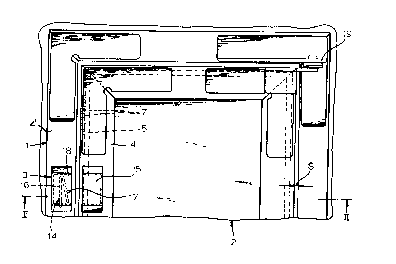Une partie des informations de ce site Web a été fournie par des sources externes. Le gouvernement du Canada n'assume aucune responsabilité concernant la précision, l'actualité ou la fiabilité des informations fournies par les sources externes. Les utilisateurs qui désirent employer cette information devraient consulter directement la source des informations. Le contenu fourni par les sources externes n'est pas assujetti aux exigences sur les langues officielles, la protection des renseignements personnels et l'accessibilité.
L'apparition de différences dans le texte et l'image des Revendications et de l'Abrégé dépend du moment auquel le document est publié. Les textes des Revendications et de l'Abrégé sont affichés :
| (12) Brevet: | (11) CA 2111666 |
|---|---|
| (54) Titre français: | PANNEAU D'ACCES INCENDIE |
| (54) Titre anglais: | FIRECODE ACCESS PANEL |
| Statut: | Périmé et au-delà du délai pour l’annulation |
| (51) Classification internationale des brevets (CIB): |
|
|---|---|
| (72) Inventeurs : |
|
| (73) Titulaires : |
|
| (71) Demandeurs : |
|
| (74) Agent: | BORDEN LADNER GERVAIS LLP |
| (74) Co-agent: | |
| (45) Délivré: | 1997-11-25 |
| (22) Date de dépôt: | 1993-12-16 |
| (41) Mise à la disponibilité du public: | 1994-07-01 |
| Requête d'examen: | 1994-05-06 |
| Licence disponible: | S.O. |
| Cédé au domaine public: | S.O. |
| (25) Langue des documents déposés: | Anglais |
| Traité de coopération en matière de brevets (PCT): | Non |
|---|
| (30) Données de priorité de la demande: | ||||||
|---|---|---|---|---|---|---|
|
La présente invention vise un panneau constitué d'un élément inséré dans une ouverture et dont le bord extérieur est généralement parallèle au bord intérieur de l'ouverture. Le bord extérieur de l'élément et le bord intérieur de l'ouverture sont respectivement garnis d'un cadre de géométrie similaire, entre les faces externes desquels un vide annulaire est aménagé. La face interne de l'un des cadres forme un compartiment annulaire sur toute la périphérie. Ce cadre comporte un ensemble d'orifices qui en traversent les deux faces et relient le compartiment au vide annulaire. Mis à part les orifices, le compartiment est essentiellement fermé. Un cordon de matériau gonflable à la chaleur est inséré dans le compartiment; lorsque ce matériau est chauffé, il gonfle et se répand dans le vide annulaire par les orifices.
The panel assembly has a panel generally fitting in a hole and having an outer
periphery running generally parallel to the inner periphery of the hole. Respective
geometrically similar inner and outer annular frames on the inner and outer peripheries
have confronting outer faces forming an annular gap around the panel between the inner
and outer frames. One of the frames has an inner face forming an annular compartment
extending around the respective periphery. This one frame is formed with an array of
throughgoing openings which extend between the respective inner and outer faces and
connect the compartment with the gap. The compartment is substantially closed except
at the openings. An annular body of heat-swellable mate rial is provided in the
compartment so that on heating of the material it swells and exits the compartment
through the openings to fill the gap.
Note : Les revendications sont présentées dans la langue officielle dans laquelle elles ont été soumises.
Note : Les descriptions sont présentées dans la langue officielle dans laquelle elles ont été soumises.

2024-08-01 : Dans le cadre de la transition vers les Brevets de nouvelle génération (BNG), la base de données sur les brevets canadiens (BDBC) contient désormais un Historique d'événement plus détaillé, qui reproduit le Journal des événements de notre nouvelle solution interne.
Veuillez noter que les événements débutant par « Inactive : » se réfèrent à des événements qui ne sont plus utilisés dans notre nouvelle solution interne.
Pour une meilleure compréhension de l'état de la demande ou brevet qui figure sur cette page, la rubrique Mise en garde , et les descriptions de Brevet , Historique d'événement , Taxes périodiques et Historique des paiements devraient être consultées.
| Description | Date |
|---|---|
| Inactive : CIB de MCD | 2006-03-11 |
| Inactive : CIB de MCD | 2006-03-11 |
| Le délai pour l'annulation est expiré | 2004-12-16 |
| Lettre envoyée | 2003-12-16 |
| Inactive : Grandeur de l'entité changée | 2002-11-20 |
| Lettre envoyée | 2000-01-21 |
| Inactive : Lettre officielle | 1999-09-08 |
| Inactive : Lettre officielle | 1999-04-27 |
| Accordé par délivrance | 1997-11-25 |
| Inactive : Demande ad hoc documentée | 1997-09-19 |
| Inactive : Dem. traitée sur TS dès date d'ent. journal | 1997-09-19 |
| Inactive : Renseign. sur l'état - Complets dès date d'ent. journ. | 1997-09-19 |
| Préoctroi | 1997-07-08 |
| Préoctroi | 1997-07-08 |
| Préoctroi | 1997-07-08 |
| Un avis d'acceptation est envoyé | 1997-04-22 |
| Demande publiée (accessible au public) | 1994-07-01 |
| Toutes les exigences pour l'examen - jugée conforme | 1994-05-06 |
| Exigences pour une requête d'examen - jugée conforme | 1994-05-06 |
Il n'y a pas d'historique d'abandonnement
| Type de taxes | Anniversaire | Échéance | Date payée |
|---|---|---|---|
| Taxe finale - petite | 1997-07-08 | ||
| TM (brevet, 4e anniv.) - petite | 1997-12-16 | 1997-12-04 | |
| TM (brevet, 5e anniv.) - petite | 1998-12-16 | 1998-10-21 | |
| Enregistrement d'un document | 1998-12-14 | ||
| TM (brevet, 6e anniv.) - petite | 1999-12-16 | 1999-11-22 | |
| TM (brevet, 7e anniv.) - petite | 2000-12-18 | 2000-08-29 | |
| TM (brevet, 8e anniv.) - petite | 2001-12-17 | 2001-06-28 | |
| TM (brevet, 9e anniv.) - générale | 2002-12-16 | 2002-11-12 |
Les titulaires actuels et antérieures au dossier sont affichés en ordre alphabétique.
| Titulaires actuels au dossier |
|---|
| OPUS PATENT-UND KNOW-HOW VERWERTUNGSGESELLSCHAFT MBH |
| Titulaires antérieures au dossier |
|---|
| CHRISTOPH LANGENHORST |